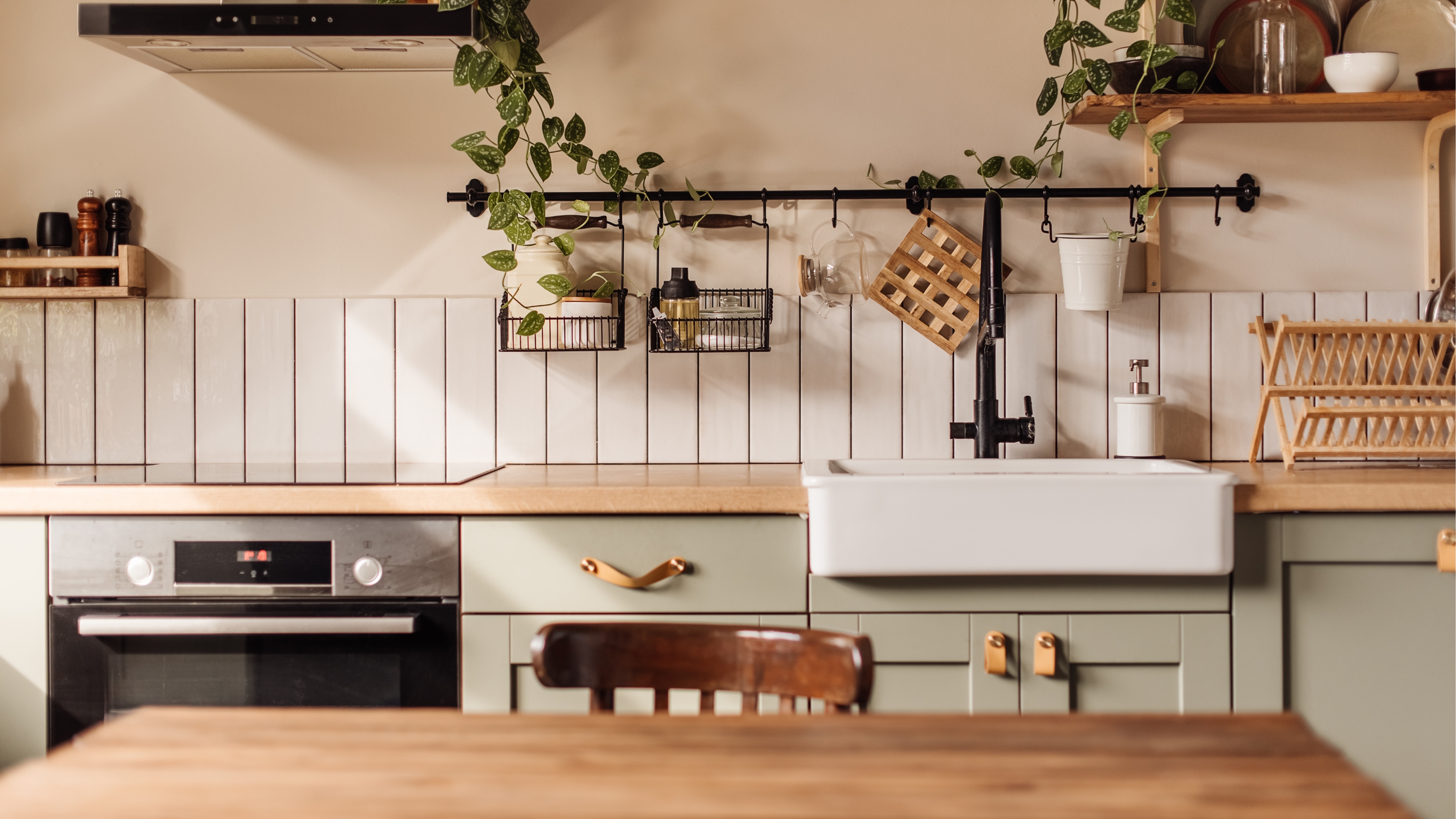How to wrap kitchen cabinets yourself – to get a fresh look for less
Learn to wrap kitchen cabinets to quickly transform the look and feel of your kitchen. Here the experts tell you how

- 1. Gather supplies
- 2. Prepare cabinets
- 3. Measure and cut vinyl
- 3. Apply vinyl
- 4. Heat and stretch
- 5. Trim excess
- Cost to wrap kitchen cabinets
- What vinyl should I use?
- Can you wrap kitchen cabinets with grooves?
- How long does it take to wrap a kitchen?
- Can you remove vinyl wrap from kitchen cabinets?

When it's time for a kitchen makeover, wrapping kitchen cabinets is one smart and straightforward solution to save you quite a bit of cash. And with a little guidance you’ll be able tackle the project yourself.
You can choose a color, texture and finish to perfectly match your design dream. You’ll get a durable and low maintenance finish that you can simply wipe clean, helping to keep your kitchen cabinets looking good for longer without the hefty cost of replacement.
Here you'll discover what tools you need, the best vinyl to use and the essential steps and techniques you’ll need to get smooth, bubble-free units and make your desired kitchen cabinet idea come to life.
What you'll need to wrap kitchen counters yourself
To apply vinyl to a kitchen cabinet you will need a few tools to ensure you get a smooth bubble-free finish.
Of course you can call in the pros, but you can do it yourself as detailed in our step-by-step below. It is something that's worth practicing a few times first on a small kitchen cabinet door or piece of waste wood
The key components for success are a felt covered squeegee and a very sharp craft knife. Once you have all the tools, follow our guide and you’ll be surprised how quickly you can pick up the art of wrapping, and how good it will look.
Here's what you'll need:
- Utility knife or craft knife: Make sure you have extra blades as you need a very sharp blade to cut the vinyl successfully. Store them away from children's reach. The WorkPro utility knife from Amazon has a retractable blade and comes with 10 spares you can change quickly.
- Squeegee or application tool: This will typically have a felt - or similar - edge and is used to push out air bubbles and stick the vinyl to a cabinet. The Art3d Smoothing Tool Kit from Amazon bundles a few items you need together.
- Measuring tape: A standard measuring tape to measure the vinyl ready for cutting. The kit above comes with one.
- Steel rule: A strong straight edge for helping get clean cuts where needed.
- Cleaning solution: A de-greaser to ensure that a kitchen cabinet surface is free from dirt, dust and grease to get better adhesion. The Easy Off degreasing spray from Walmart is highly rated by customers.
- Heat gun: To heat the vinyl so that it is more pliable and fits to the surface.
Step 1: Gather supplies
Make sure that you have all your tools ready and close by, and make sure you have a large clean flat area such as a table or bench to work on. Here Jay Sander, Owner of Maryland Contractors, who has been working in construction for over a decade, reveals his top tips and the steps needed to wrap kitchen cabinets well.
Design expertise in your inbox – from inspiring decorating ideas and beautiful celebrity homes to practical gardening advice and shopping round-ups.
Step 2: Prepare cabinets
All surfaces should be cleaned thoroughly to remove any dirt and grease with a de-greaser so that the vinyl adheres properly and lasts longer. You can use an all-purpose spray such as the Formula 409 Multi-Surface Cleaner Spray from Walmart. Sugar soap works well too for cabinet prep. After using, remember to wipe down the surface with clean warm water and leave to dry.
Step 3: Measure and cut vinyl
Then measure your cabinet doors and cut the vinyl accordingly. Don’t forget to leave a few extra inches on all sides to wrap it around the edges.
Remember to measure twice and write down the sizes so you are less likely to get it wrong.
Step 3: Apply vinyl
Peel a small section of the vinyl from the backing paper and start applying it to the cabinet door. Start at the top and work across to the opposite corner, peeling off the backing paper as you go. If you see any bubbles use a squeegee to smooth them out.
The Gomake Vinyl Wrap Kit from Amazon is their bestseller and comes with multiple helpful items including a squeegee tool.
Step 4: Heat and stretch
Next heat the vinyl using a heat gun or hair dryer, to make it more pliable. This will ensure a tight fit according to the cabinet's shape.
Step 5: Trim excess vinyl
After the proper application of vinyl, trim the excess carefully with a utility knife, to ensure clean cut edges. If needed, use a straight edge like a steel rule.
To ensure that you get a tight fit around the corners of cabinets and doors there is a simple method to use. Make a diagonal cut in the excess vinyl from the edge of the vinyl to the corner of the door or cabinet. Now fold down one edge, fold down the other edge and trim off the excess.
FAQs
How much does it cost to wrap kitchen cabinets?
If you are confident enough in your DIY skills to take on the challenge of wrapping kitchen cabinets yourself, you can save some serious dollars on labor costs. And you won’t need to splash out big on tools.
Your biggest outlay will be the vinyl itself. Jay Sander, Owner of Maryland Contractors says, “Material costs would be around $100 to $200.” But of course this will depend on how many cabinets are being wrapped and the type of cabinets being wrapped – flat or grooved.
Obviously prices will increase if you call in the pros, “In case of professional services it can cost you around $1,500 to $3,000 depending on the size and complexity of the kitchen” reveals Sander. “But, still a cost-effective alternative to a full renovation.”
What type of vinyl should be used for wrapping?
There are a few different vinyl producers that work well on kitchen cabinets. Farook Member, Cabinet Expert at QS Supplies suggests the following, “The best types include 3M DI-NOC, Oracal 631, and Avery Dennison. These vinyl wraps are designed to withstand kitchen conditions, including heat, humidity, and cleaning.” And they, “Offer a wide range of finishes, from matte and gloss to textured patterns, ensuring you can find a style that suits your taste.”
“3M Gloss Cabinet Wraps are highly recommended for the kitchen cabinets,” shares Sanders. “It gives a high-gloss finish and is easy to apply. It’s perfect for DIY projects.” he adds. “These wraps are durable having a lifespan of five to seven years if taken proper care.”
Can you wrap kitchen cabinets with grooves?
“Yes, you can but it requires a different technique compared to flat surfaces,” explains Sanders. “Set your heat gun to 200-300°F. This will make the vinyl more pliable for getting it into the grooves without air bubbles.” But make sure not to leave the heat in one spot on the vinyl for too long, just long enough for it to be malleable and stick to the surface.
Sanders offers a tip for a better finish, “Cut the vinyl into smaller pieces to fit into the grooves. This is done before applying the main sheet as it gives a smooth finish.”
How long does it take to wrap a kitchen?
This very much depends on the size and complexity of the kitchen and your skill level if doing it yourself. A small eight cabinet kitchen should be completed in a day. Obviously, larger kitchens will take two to three days.
If you are getting the job done professionally, the contractor will often take away removable parts like doors and wrap them at their base and bring them back to fit them. This could speed up the process. Consult with your contractor to find out more.
Can you remove vinyl wrap from kitchen cabinets?
Yes you can, but be warned it can be a slow and painful process. You will need a heat gun to warm up the vinyl. Start in a corner and when the vinyl starts to lift, grab the edge of the vinyl and gently push in a plastic scraper to lift it off the surface, repeat this across the surface until all the vinyl has been removed. Finish by using a cleaner to get rid of any leftover residue.
Giving your kitchen cabinets a refresh could be just a small part of a kitchen makeover. Check out our 11 remodeling kitchen ideas and 22 stylish but practical floors for kitchens guides to help you get the perfect kitchen.

Steve has been a homes writer and editor for two decades, regularly contributing to brands like Homebuilding & Renovating Magazine. He is an avid DIYer with over 20 years of experience transforming and renovating homes. He specializes in painting and decorating but has strong all-around building skills, having worked in the industry for ten years.